On the one hand it’s easy to see why the United States and its NATO allies in Europe would want to get together from time to time to check that their military forces can work cooperatively. On the other hand, of course, one can understand why Russia is uneasy and somewhat annoyed about such activity on its very doorstep. But, let’s face it, neither side trusts the other, and if you’re going to gather together troops and matériel, it makes sense to do so close to where any hostilities are most likely to take place: the continent of Europe, from the Baltic to the Black Sea. The actual event, codenamed Defender Europe 2020, is said to be the largest military exercise for a quarter of a century. Even so, it’s only the third largest military exercise to be held in Europe since the end of the Cold War, according to Lt. Gen. Chris Cavoli, the United States Army Europe commander. According to Defence News, Lt. Gen. Cavoli said “it will test the US Army’s ability to deliver a force from ‘fort in the United States to port in the United States’, and then onward to ports in Europe and from there to operational areas throughout Europe from Germany to Poland, to the Baltic States and other Eastern European nations, Nordic countries and even Georgia.”
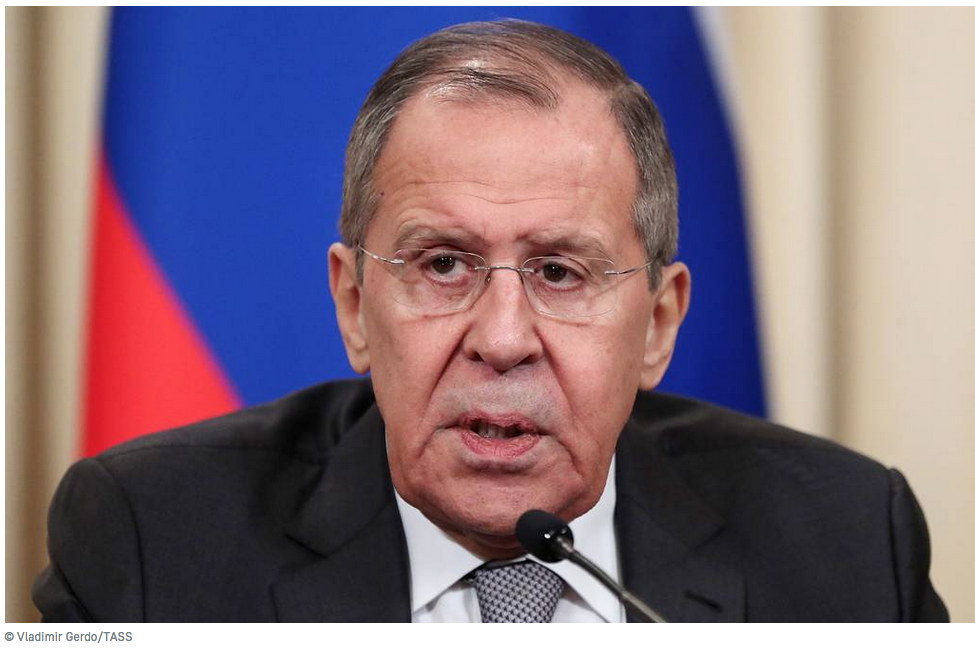
But nobody in the West can be really surprised that the plan has not brought a warm smile to the face of Vladimir Putin, nor to the faces of other Kremlin insiders and Russian military leaders. Russia’s Foreign Minister, Sergey Lavrov, quoted in Rossiyskaya Gazeta, described the exercise as “greatly concerning” to Smolenskaya Square in Moscow, where the Russian Foreign Ministry is based. Despite his clear annoyance, though, Lavrov seems to be keen to play down the danger of confrontation. “Naturally, we will react,” he said. “We cannot ignore processes that arouse very great concerns. But we will react in a way that will not create unnecessary risks.” He added: “It is noteworthy that everything that we do in response to NATO’s threats to our security we do exclusively in our own territory.” Western leaders may note that in his view “our own territory” includes Crimea and Eastern Ukraine, not an opinion shared in Kyiv. Most would agree that the Defender Europe 2020 exercise is intended as a warning to Moscow not to repeat its expansionist activities elsewhere on the continent. Or anywhere else at all, for that matter.
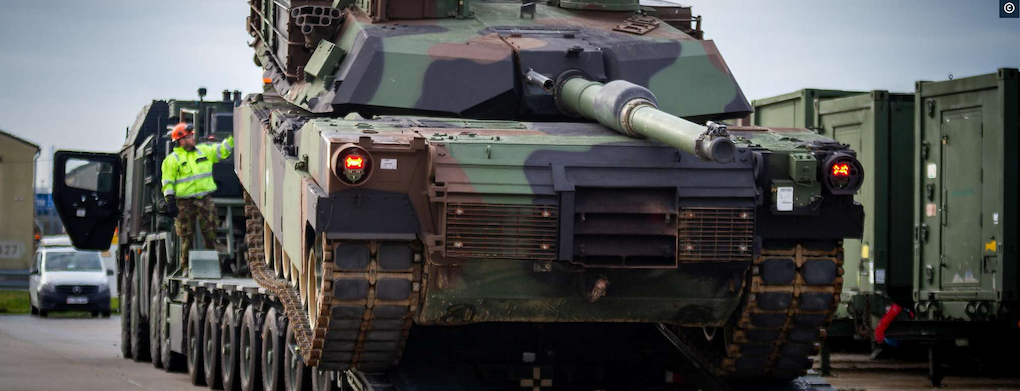
So, Defender Europe 2020 is a big, division-scale exercise: 20,000 soldiers, from bases right across the United States board planes and load equipment onto ships, all headed for Europe.
Once there, they work side-by-side with 17,000 troops from a number of European armies. The logistics trains and communication lines will stretch from the Baltic Sea to the Black Sea. The exercise will involve “a little bit of everything,” Chief of the Polish armed forces, Gen. Rajmund Andrzejczak told Breaking Defence, “a little bit of national regulation, a little bit of crisis, a little bit of high intensity, cyber, conventional, national, bilateral, NATO, everything. We have to accept we’re living in a complex security environment.” No-one would argue on that score. And, of course, it comes with a heavy price tag. Moving and sustaining thousands of troops for months at a time, along with tanks, artillery and armoured vehicles, not to mention ships and aircraft, will cost the United States a hefty $340-million (€310-million), although the NATO allies are paying for their participation in the multinational drills. According to Breaking Defence, US Army Europe is defending the cost, saying in a statement: “We make every effort to prudently use taxpayer dollars to ensure that this event supports the U.S. government’s goals and interests,” Breaking Defence adds that a spokesperson had also pointed out that planning for Defender “is already spurring strategic investments in host countries. For example, Lithuania is improving their rail system and Deutsche Bahn has invested in additional heavy rail cars ahead of the exercise.”

General Rajmund Andrzejczak
© Pol/gov
It’s not the only example of European-US cooperation over transportation issues. According to defence blogger Eddy Verhaeghe, Lavrov said that “in the context of NATO’s cooperation with the EU in the military sphere, they invented the term ‘Military Schengen’, which envisages the upgrading of all transport arteries up to NATO’s eastern border in such a way that any military vehicles, even the largest, can move without hindrance to the east. I think that this fact alone is enough to understand the danger of such games. Of course, we have to respond to it.” However, as Verhaeghe points out, “Russia has been upgrading its transport arteries to its western border for many, many years and when the West belatedly reacts, this becomes a danger.” Of course, it’s worth remembering that the number of troops involved in Defender Europe 2020 is dwarfed by the numbers Russia has deployed in its own exercises on NATO’s border. Moscow knew that it was engaged in an act of intimidation, so it’s not surprising that it views Defender Europe 2020 as a “cold siege” of Kaliningrad, the Russian province on the Baltic Sea, squeezed between Poland and Lithuania.
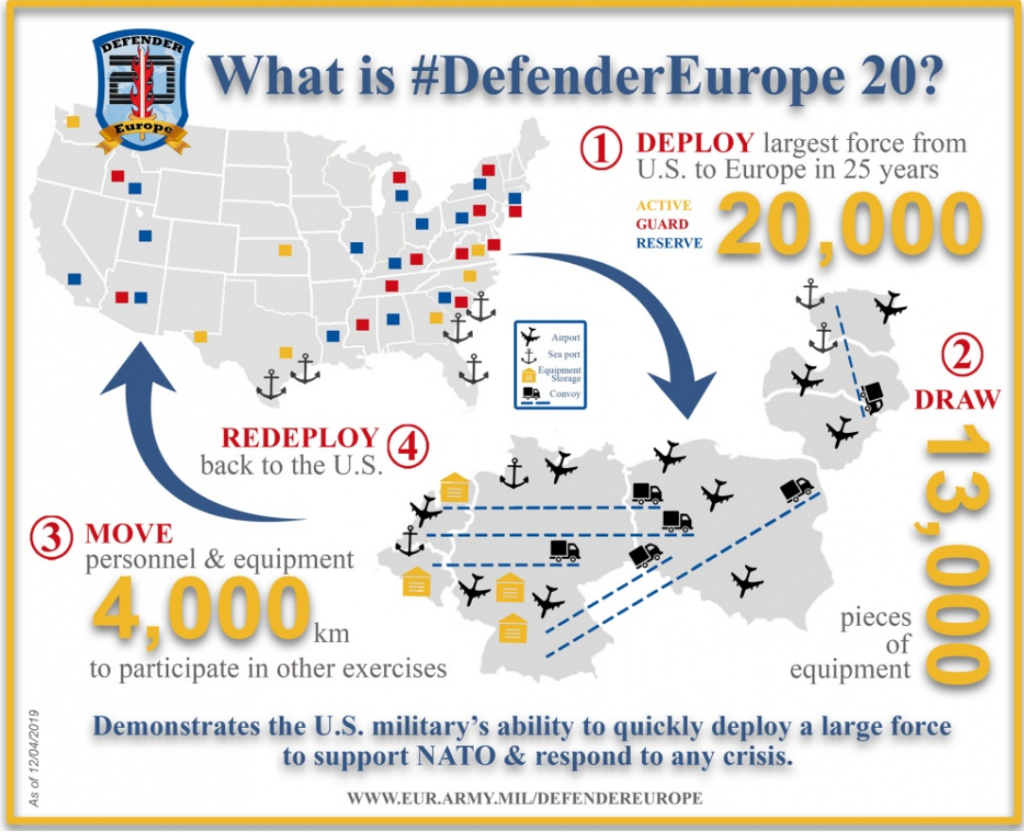
WHO’S THE ENEMY?
The Russian news agency TASS quotes Lavrov as saying “The United States and NATO have claimed that this exercise is not aimed at Russia, merely at preparing the forces to cooperate against a common enemy. Whoever that might be.” He is clearly doubtful of the claim that it’s all about defence. “Who are they going to defend themselves from? They claim that they have to defend themselves, not from Russia, but from an adversary whose potential is identical to that of NATO,” Lavrov said. “Here it will be very hard to find the correct target for these efforts, matching the comparability criteria. One look at the official statistics – not ours but foreign – concerning military spending, military equipment and all types of armaments without any exception will be enough to see that NATO’s European members alone, the US component excluded, surpasses our armed forces more than by half. I have no idea where they have found a comparable opponent.” According to TASS, Lavrov says it is not Russia but NATO that is the dominant military force in this particular theatre. “Although the entire space there is oversaturated by military facilities and weapons, although NATO’s eastward expansion has already created serious problems in the field of strategic stability in Europe, the merger of NATO and the EU is continuing,” he told TASS. “NATO members have been trying to hold joint exercises and trying to plug in neutral EU members, such as Finland and Sweden.” He added, with a certain amount of (probably unintentional) irony: “I believe that this is enough to realize how dangerous such games are.” Yes, I think everyone agree, but if it takes two to tango, it also takes two to stop tangoing.

Lavrov is also concerned because Defender Europe 2020 is not really a joint US-NATO operation, he argues, but a US operation in which NATO forces are co-operating. “One remarkable detail. I’m really curious about the reason,” he said. “One of the possible ones is the Americans find it far easier to do all the planning themselves and to carry out everything on their own, with no regard for NATO discipline. Although in NATO the US commander in Europe is also the commander of NATO forces in Europe.” You have to admit, that’s a fair point.

Russia Today (RT) is Russia’s equivalent of Fox News: it faithfully publishes the views of its country’s leadership without thinking of questioning it much. Just as Fox is unwaveringly pro-Trump, pro-Republican, so RT is equally unwaveringly pro-Putin, and, as such, perhaps more accurately reflects the views of a great many Russians than does the more cautious and diplomatic TASS. RT’s military commentator is Mikhail Khodarenok, a retired colonel who served as an officer at the main operational directorate of the General Staff of the Russian Armed Forces. “Despite NATO officials’ claims about Defender Europe 2020 not being aimed against any particular country, the exercises are clearly just another anti-Russian provocation,” he told RT. “The main objective of the exercise — NATO’s largest in over 25 years — is to practise deploying US troops to Poland and the Baltic states. As part of the drill, up to 20,000 US troops will be deployed to Europe by air and sea, as well as 13,000 vehicles and equipment. 37,000 soldiers from 18 countries will take part in Defender-Europe 2020 altogether. These exercises will last about five months, and will take place mostly in Germany, Poland, and the Baltic states, with the bulk of the activities scheduled for April and May.”
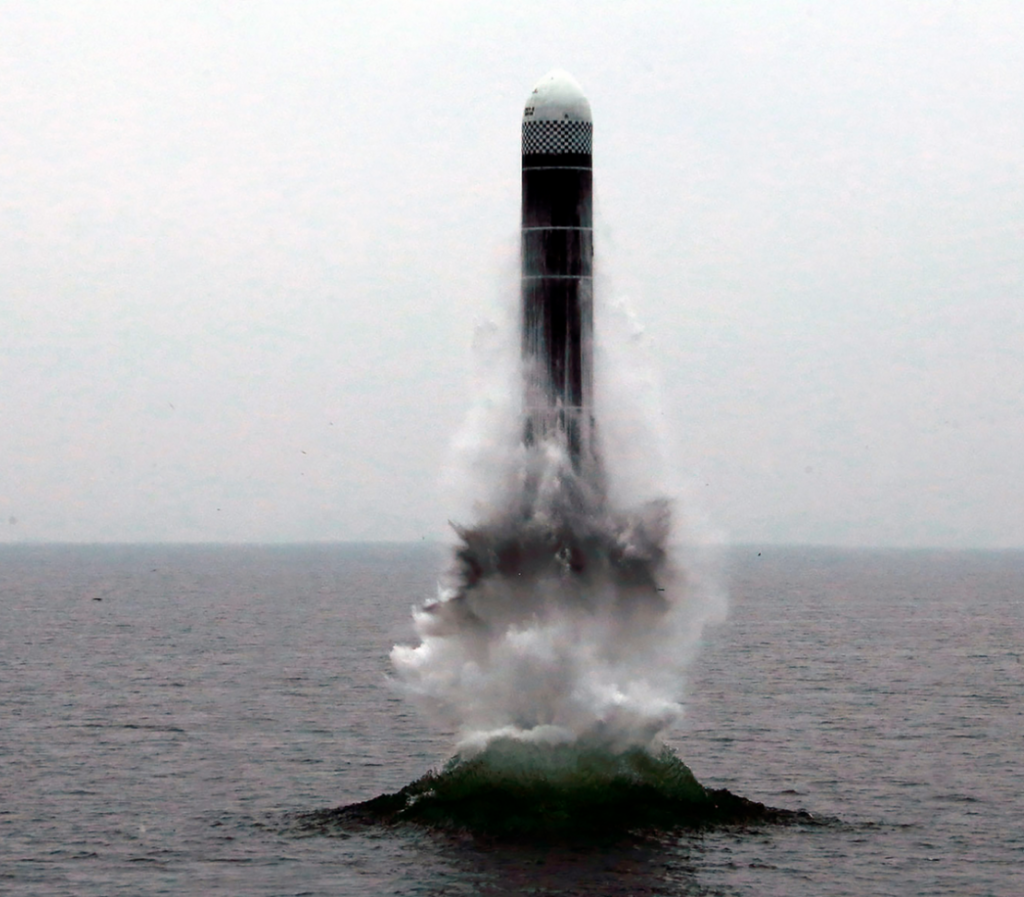
ballistic missile, the JL-3
MIND HOW YOU GO
If this is simply Washington sabre-rattling, then it’s using a long sabre, because the US is also organising Defender Pacific later this year. This will be a smaller exercise than the European version and comes a few months later, “but it will still be one of the largest exercises conducted by the U.S. Army and its partners and allies in the region since Team Spirit drills in South Korea ended in the early 1990s”, according to acting U.S. Army Pacific Commander Lt. Gen. John “Pete” Johnson, as reported in Defense News. The Army will send roughly 12,000 soldiers into the region this September for the exercise, which is fuelled by a rising China, characterized in the National Defense Strategy (NDS) as a ‘long-term, strategic competitor of the United States’. The NDS lays out a world where great power competition rather than counterterrorism will drive the Defense Department’s decision-making and force structure. So, this is Washington raising a cautionary finger to both Moscow and Beijing in a single year. Perhaps it’s just coincidence that it’s a presidential election year.

NATO and the US seem desperately keen to suggest that neither exercise has a particular enemy in mind. RT quotes General Andrew Rohling, Deputy Commander of US Armed Forces in Europe, as saying “the military manoeuvre is not related to any particular country. It aims to respond quickly to any crisis.” This view was echoed by NATO Secretary General Jens Stoltenberg, who said (as a great many others seem to have done) “Defender Europe 2020 is not aimed at any particular country.” It’s a view with which RT has little sympathy: “Needless to say, NATO has only one potential enemy in the European strategic region that is somewhat equal to the alliance in terms of military capabilities. No matter what NATO’s political and military leaders say, it’s Russia.” It’s hard to argue that RT is wrong in this conclusion but given Russia’s own military aggression in the region, its various shows of strength and its acquisition of territory that formerly belonged to other countries, Moscow can hardly be surprised, nor should it react with mock surprise and horror, like a prim elderly aunt finding her upstairs maid and the butler in a compromising embrace.
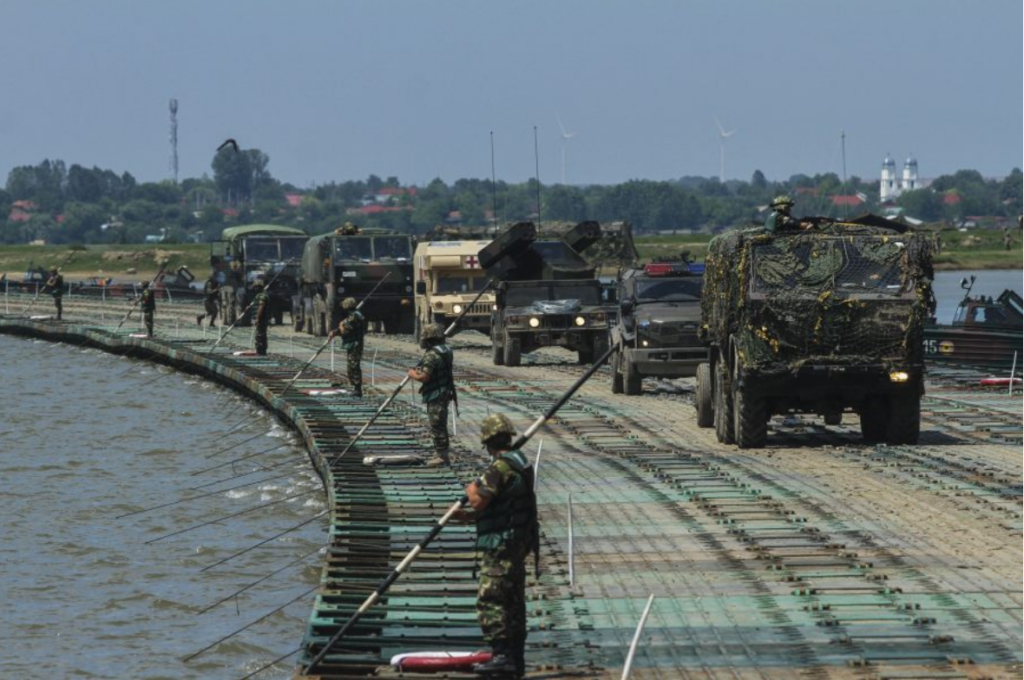
Indeed, in the military website Tasks and Purpose, there is no pussy-footing around. The two giant exercises have a clear purpose: “The first ‘Defender Pacific’ — the Pentagon’s most significant exercise for the region in 2020 — is expected to be followed by an even bigger version involving more than 10,000 mainland soldiers,” says the website. It goes on to quote Gen. Robert Brown, former commander of U.S. Army Pacific at Fort Shafter, who “likes to point out that the United States is in a state of strategic ‘hyper-competition’ with China and Russia.” The US argues that weapons development and deployment as well as on-the-ground ambitions, have forced a change in the game plan. “Advanced missile systems —particularly those of China — have ‘changed the equation out here in the Pacific’ and made it more difficult for U.S. forces to gain access to potentially contested environments in what’s called anti-access/area denial,” said the four-star general in an interview with the Honolulu Star-Advertiser. “China’s road-mobile DF-21D ‘carrier killer’ missile, for example, has a manoeuvrable warhead, a range exceeding 930 miles and the ability to target aircraft carrier strike groups in the Western Pacific.” In addition, of course, China has been claiming large areas of the South China Sea where it has been constructing artificial islands and arming them with the latest weaponry. To counter it, the US is developing long-range firepower, improving the range and lethality of its missiles and artillery. In its 2015 Defence White Paper, China set out its ‘military strategic guideline’, recommending changes to the security environment that included “accelerated worldwide use of ‘long-range, precise, smart, stealthy, unmanned weapons’,” going on to say that the People’s Liberation Army (PLA) must prepare to fight and win, including preparations for a ‘maritime military struggle’. And if that didn’t worry Western navy chiefs, they may be concerned that the policy also stated: “the traditional mentality that land outweighs sea must be abandoned”. Jules Verne’s fictional Captain Nemo rides again.

head of NATO Allied
Land Command © Nato
BIGGER AND DEADLIER
Tasks and Purpose reports that the US “Army, Navy and Air Force are developing hypersonic weapons that attain speeds of more than Mach 5, or five times the speed of sound — at least 3,800 mph — and have a range of 1,400 miles. The Army is expected to field a prototype by fiscal year 2023.” Brown reminds readers: “If you can kill a ship from land, you can influence a lot of things,” including securing key choke-points in the South China Sea. Chinese advances in the region, coupled with aggressive rhetoric, have worried Washington for some time. The US website National Interest, reports a speech last July by Admiral Phil Davidson, Commander of the US Indo-Pacific Command, who described comments by China’s Defence Minister, General Wei Fenghe, as “quite chilling”. “Not only did [Wei] make it clear that he didn’t think Asia and the Western Pacific was any place for America, he said Asia wasn’t even for Asians—it was for the Chinese.” Then, “within 24 hours of that they tested a new nuclear ballistic missile,” the submarine-launched JL-3. It’s a bit unfair to react with shock to the missile. It was only in December that the United States test-fired a missile that would have been banned under the Intermediate Range Nuclear Forces Treaty (INF), signed in 1987 by Reagan and Gorbachev and abandoned by Trump last year, following claims that Russia had reneged on it by firing an SSC-8/9M729 missile of its own. Moscow denies breaching the Treaty.
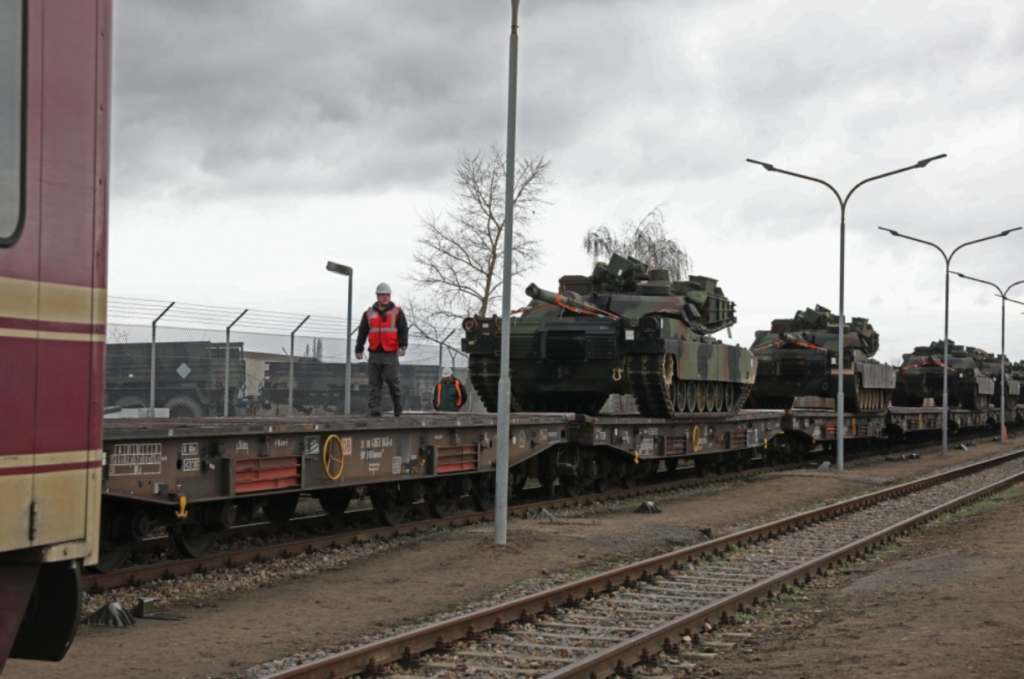
So, we’re now into a fairly typical Cold War scenario that sounds more like a script for a British children’s Christmas pantomime, if you are familiar with the concept: accusations, clownish denials and counterclaims with a lot of outraged huffing. The thing is, everyone involved knows the script backwards and nobody is being fooled for a moment. It’s a game of “I’ve got bigger, scarier weapons than you and I’m not afraid to use them!” There can be no real winners, of course. Schoolboys may recall playing similar games in the boys’ toilets; it was pretty disgusting then and it still is, and yet we continue to play. These days, what started out as a game of ‘brag’ has become a game of ‘chicken’, with the added risk that the chicken itself could be slaughtered, plucked, stuffed and vacuum-packed at any moment. Possibly chlorinated, too.

RT’s Mikhail Khodarenok muses on what SHAPE (Supreme Headquarters Allied Powers Europe) might say to describe Defender Europe 2020. Is it, he asks, “to prevent Russian forces from reaching the Baltic Sea near Liepaja and Klaipeda thus isolating NATO’s units in Latvia and Estonia? Or maybe to prevent Russians from crossing the middle reaches of the Vistula river in Poland on a wide front? Possibly both, I suppose, but then given how many Poles are aware of their history, especially September 1939 when between 500,000 and a million Red Army soldiers swept into Eastern Poland, perhaps they feel the need to practise armed resistance. After all, Stalin didn’t properly declare war back then; he just acted upon the secret protocol to the Molotov-Ribbentrop Pact that gave him and Hitler an equal share of Poland. Nobody asked the Poles, who were putting up spirited resistance to the Wehrmacht at the time, and could have held up the German advance for longer if the Russians hadn’t invaded sixteen days after the Germans. Stalin said it was to protect Western Ukraine and Belorussia, a view that was even backed by the exiled Leon Trotsky, no lover of Stalin. Trotsky believed it was necessary for the defence of the Soviet Union. His many supporters in the West found that disturbing and alarming. He changed his mind later, blaming Germany’s victory in Poland on “the sinister and criminal rôle played by the Kremlin”, according to Joshua Rubenstein’s book, Leon Trotsky, a Revolutionary’s Life.

PLUS ÇA CHANGE
That was then and this is now and you’d be forgiven for thinking that attitudes seem oddly familiar. It’s largely a blame game, citing the aggression of the other side as an excuse for stepping up your defensive capability. This, in turn, is the excuse for the other side to step up theirs. Lt. Gen. J.T. Thomson, head of NATO Allied Land Command, told Defense News that the Defender Europe 2020 exercise will involve at least 15 NATO countries, plus two partner nations, and NATO specifically will participate at the corps level down to tactical level. “From a land forces standpoint, the demonstration of collective defence is our best deterrent,” he said. “We’re actually doing collective defence, and I stress collective, just not one or two nations. This is from fort to port. This isn’t just a river crossing or a specific fight, it’s very comprehensive in nature.” This is really the West responding to a series of Russian moves that look suspiciously imperialist to outsiders.

and the Chairman of the NATO
Military Committee, Air Chief Marshal
Sir Stuart Peach
The United States and Europe believe a show of strength will also test their ability to work together against a common enemy, even if they deny that the enemy they have in mind is Russia. “For NATO, its ability to receive forces and equipment from the U.S., stage them, move them forward onto the battlefield and integrate them will be the focus throughout the exercise,” writes Defense News, which notes that although there have been previous simulations, “in this case, we’re not simulating it, we are doing it,” said Thomson. “Once those forces get integrated, we’re actually going to conduct defensive operations collectively.” The aim is to evaluate two things: the state of military mobility , and ensuring that countries can operate seamlessly together, which Thomson said were “also the biggest challenges”.
Russia, meanwhile, has worked closely with its own allies in preparing for war. Radio Free Europe described the massive exercise launched last September, codenamed Tsentr-2019. “Forces from China, India, Pakistan, Kazakhstan, Kyrgyzstan, and Uzbekistan joined Russia’s Central Joint Strategic Command (JSC) for exercises running through September 21,” the on-line article said. “The annual exercises rotate and this year’s mainly focus on the Central JSC. The other JSCs are West, East, and Caucasus.” Russia claimed that these were anti-terrorism exercises, although outside observers were not convinced. For such exercises, would Russia really need “128,000 personnel, 20,000 pieces of equipment and weapons, 600 aircraft and helicopters, and 15 warships,” as the Jamestown Foundation has estimated? Radio Free Europe also notes that “In the 2015 exercises, for example, 95,000 personnel took part and they were used as a preparation for Russian operations in Syria, according to the Russian-language Military and Industrial Courier.” The Jamestown Foundation claims that last year’s exercises “look less like preparing for counterterrorist actions, than for inter-state war; this has been a feature of all Russian strategic exercises in recent years.” Estonia’s International Centre for Defence and Security is sceptical but concerned. “According to information officially released by the Russian side (the actual strength may have been exaggerated, as is traditional),” says its website, “in total the exercises assembled the following forces: 128,000 military personnel, more than 20,000 pieces of special military equipment, over 600 aircraft of various types (jets, helicopters and drones) and 15 warships. The geographical scope of the exercises was also impressive, involving six different areas located on Russian territory stretching from the North Caucasus to Western Siberia, while some elements took place in the partner countries.” And yet Russia claims to be disturbed by Defender Europe 2020, which is not as massive. I suppose they have to appear annoyed, but never actually worried by such things.

For the US forces, working in Europe has its drawbacks. Defense News reports that in 2017, during the exercise Saber Guardian, the US Army Supreme Commander Europe of the time, Lt. Gen. Ben Hodges, flew on a Black Hawk from Bulgaria to Romania when he and the crew were warned that they may have to land for an ‘unanticipated customs check’. This sounds more like deliberate puerile pettiness than a genuine attempt to ensure the general wasn’t smuggling vodka and cigars. The delay would have meant that the General, who was leading the entire exercise, would miss a live-firing demonstration on the Black Sea. According to Defense News, it took a few emails and phone calls to get the matter cleared up. It was then that Hodges called for the creation of a “military Schengen Zone” to ensure military mobility across Europe. Even so, according to Thomson, obstacles persist. “During Defender, participants must move massive amounts of equipment and troops across countries in the northeast of the continent. The effort will test infrastructure and border policies. Forces will have to cross through EU member countries and nations that are not part of the organization, such as Norway, and each nation has its own set of rules, policies and procedures.” Defender Europe 2020 is designed to uncover all these wrinkles in defence planning and, hopefully, iron them out. Thomson admits that interoperability has long been a challenge for NATO, even within single member states. “I’m fond of saying there’s no such thing as 100 percent interoperability, not even within nations,” Thomson told Defense News, but “we are headed in the right direction on interoperability. We test it and train on it daily across NATO through work with the enhanced forward presence units in Poland, Latvia, Lithuania and Estonia and at other episodic exercises.”

THIS FAR, NO FURTHER
The gradual build-up of US military presence in Europe followed Russia’s annexation of Crimea in 2014. Washington wanted to deter Moscow from trying the same thing elsewhere. But Defender Europe 2020 is a massive and complicated exercise. As reported in Breaking Defense, Brig. Gen. Sean Bernabe, deputy chief of operations at US Army Europe, recently told reporters on a conference call that during the exercises, they’ll loop in key headquarters from NATO like the Allied Rapid Reaction Corps and Multinational Corps Northeast to “allow them to practise commanding and controlling large-scale ground combat operations in simulation or in microcosm live exercises,” in order to build readiness for NATO as a whole.
But even reaching that stage sounds like a coordination nightmare. “Some US units, like the 116th Armored Brigade Combat Team of the Idaho Army National Guard will fall in on prepositioned stocks already in Europe, while others, like the 2nd Brigade, 3rd Infantry Division will load their Abrams tanks, Bradley Fighting Vehicles, and howitzers on ships bound for Bremerhaven, Germany. From there, the soldiers will link up with their gear and then continue to move that equipment across the continent,” Bernabe said. Much of the heavy equipment will be moved along civilian roads at night to minimise interference with ordinary traffic. One supposes that a lot of this expensive hardware will then have to be shipped home, although it’s possible that some may remain in or near the Baltic states as an insurance policy.

and Black Sea fleets © kremlin/ru
There is a close relationship these days between the US and Poland, partially because the Law and Justice Party shares with Trump a fairly right-wing view of the world that disregards conventions. According to Breaking Defense, “Under Defender, the 1st Cavalry Division will lead a division-sized exercise at Poland’s Drawsko Pomorskie Training Area in north-western Poland, a key part of Warsaw’s increasingly close relationship with Washington. As part of a recent deal with the Trump administration, Poland eagerly agreed to host another 1,000 US troops on a rotational basis in the coming years on top of the 4,500 who already operate in the country.” Meanwhile, Defender Europe 2020 will look for ‘bugs’ in European logistics networks, ranging from possible hold-ups on the railway network to problems that could arise from Chinese ownership of some European ports. IT experts will also be on the look-out for Russian disinformation activity and hacks, together with possible acts of electronic warfare, such as the jamming of GPS, which happened during a previous exercise.
British army vehicles were disembarked at the Belgian Port of Antwerp in early February in readiness for the exercise. “The planning in itself is deterrence because it teaches our [troops] what’s involved when you start to embrace an activity of this magnitude and what you have to be prepared to do to successfully pull it off,” said Supreme Allied Commander Europe, General Tod D. Wolters. “The overarching goal of the event is to demonstrate the ability of the U.S. to lift and shift a division-size force over long distances.” According to SHAPE, “In total more than 20,000 pieces of equipment will be moved to continental Europe.
The arrival of British Forces and equipment in Antwerp, just one of the dropping points in the build-up to the exercise, will allow for convoys to travel across the continent to preposition equipment and other resources. The convoys will travel a total of approximately 4,000 kilometres to stage for the exercise proper.” NATO says that “the focus of the purely defensive exercise is to practice the rapid deployment of large-scale forces across the Atlantic into Europe where they are then supported by participating Allied and Partner nations. During the initial phases of the exercise, nations will stage equipment in 14 air and seaports across 8 European countries in preparation for the exercise proper to begin.”
Needless to say, Russia’s political-military leadership will continue to criticise NATO for accepting former Soviet bloc members (enlargement) and for staging military exercises close to Russia’s borders, but its own exercises and its annexation of Crimea are what lie behind western attitudes. There was a time, when Reagan and Gorbachev seemed to be getting pallier and Margaret Thatcher described Gorbachev as someone she “could do business with”, when the prospects of an end to the threat of war seemed feasible. But how few now remember the speech of President Dwight D. Eisenhower in 1953: “Every gun that is made, every warship launched, every rocket fired signifies, in the final sense, a theft from those who hunger and are not fed, those who are cold and not clothed. This world in arms is not spending money alone. It is spending the sweat of its labourers, the genius of its scientists, the hopes of its children.” Of course, today’s political leaders don’t see it that way, and nor does the military-industrial complex Eisenhower distrusted so much. I hope one of his other comments is correct: “I think that people want peace so much that one of these days governments had better get out of the way and let them have it.” Don’t hold your breath.
Tobias Bowman-Grant
Click here to read the 2020 March edition of Europe Diplomatic Magazine


